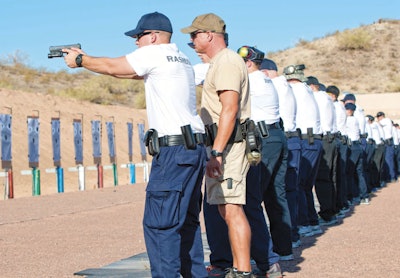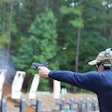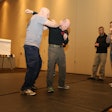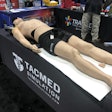 Photo: Mark W. Clark
Photo: Mark W. Clark
Even in the good economic times of the last decade, it was a problem. Ammunition costs were outpacing police training budgets. No one's quite sure why the ammo became so precious. Some point to demand from the military; some say the Chinese drove up the price with their appetite for copper; still others believe the price of ammo went up just because the manufacturers had an opportunity to raise it.
Regardless of reason, the price of ammo skyrocketed and police training budgets were not ready for it. Former San Diego sergeant and rangemaster Dave Douglas remembers when the price of ammo zoomed 40 percent around 2003, shocking his training budget. Douglas retired from the San Diego PD before the real ammo shock. Now he serves as rangemaster for a tiny police department in central Colorado.
That Colorado agency has only six officers. So Douglas has now experienced the ammo crunch on one of the nation's largest agencies and one of the nation's smallest. He says cost per round is much greater at the small agency than it was in San Diego. "It's a few thousand rounds for small agencies. It's a few million for larger metro agencies," he explains.
The bottom line is that the cost of ammo has police agencies scrambling for ways to cut their firearms training budgets while still maintaining standards. Some are walking a very dangerous line where their solution to the problem has been to cut back on firearms training opportunities both for in-service personnel and for recruits. Others are looking for ways to achieve the same training goals without sending ammo down range.
Dry Fire
Noted handgun trainer, firearms author, and retired Montgomery County (Ohio) Sheriff's Office lieutenant Dave Spaulding says many agencies could save a lot of money on ammo by teaching recruits using dry fire. "Many essential skills such as reloads, clearing malfunctions, and drawing from the holster can be done dry fire," Spaulding argues.
Spaulding says it takes about three days and 500 rounds to make most recruits proficient enough to qualify with a handgun. But trainers could reduce the number of rounds down range substantially by teaching students with dry fire. "You need live ammo for trigger control, reset, and follow-up shots," he says. "Otherwise, you can use dry fire."
So if dry fire would accomplish the training goals much more cheaply why is it rarely used? "I think my gut feeling is that firearms instructors are concerned about the entertainment factor,” Spaulding says. “To have students standing there doing dry fire drills without anything going bang is not entertaining."
Many agencies may soon find themselves unable to provide such entertainment. Shrinking tax revenues, ballooning gas prices, and the rising cost of ammo have law enforcement firearms training programs stretched to the breaking point and looking for alternatives to costly training ammo.
Laser Guns
One alternative that many firearms trainers are beginning to champion is the idea of using lasers for essential skills training such as trigger control.
Back in 2009, research was conducted at the Federal Law Enforcement Training Center (FLETC) in Glynco, Ga. Instructors at FLETC worked with two groups of students who had little or no experience with handguns. Half of the students were trained with live ammo and the other half with guns fitted with lasers inserts. Both groups of students were then required to qualify with live ammo. The difference in performance between the two groups was statistically insignificant. FLETC duplicated these results using both local college students and U.S. Marshal Service recruits.
The FLETC study shows that much of a basic firearms training program can be accomplished without firing live ammo. And that's good news for the makers of laser training pistols and laser training devices.
One of the most popular laser systems for firearms training is the SIRT (Shot Indicating Resetting Trigger) Training Pistol sold by Next Level Training. The SIRT Training Pistol is designed to emulate the Glock 17/22 pistol in weight and ergonomics. It has an adjustable resetting trigger, and it has dual indicator lasers to help students learn how to prep the trigger and to see how trigger control affects each shot.
Bill Heutmaker of Next Level Training says the SIRT pistol is becoming more and more popular with law enforcement. "They are looking for viable products for maintaining muscle memory and teaching weapons manipulation without firing a bunch of ammo," he says.
SIRT Training Pistosl list for about $220 to $450. That may seem high for an emulated gun, but training officer Brian Buchanan of the Hamilton (Ohio) Police Department says SIRT guns offer a quick return on investment. "We are doing a lot of things that we would have done live fire using the SIRT pistols," he says. "We purchased them last year and that initial investment has already paid off."
The SIRT pistol cannot fire live ammo. So it can be used safely in places where a real handgun cannot be used. "I shoot Styrofoam cups in my office sometimes," Heutmaker says. "You don't have to have a target system to make it work."
While a range system is not required to use the SIRT. There are companies that are developing reactive targets for the training gun. Heutmaker says SIRT users will soon have access to a variety of target systems, including poppers and shoot-no-shoot simulations. Some of these targets will be sold on DVDs that users can show on their TVs, others for digital projectors, and others for inexpensive simulator systems. Heutmaker says prices for these targets and systems will likely range from $30 to more than $1,000.[PAGEBREAK]Next Level Training is working on producing more emulated handguns, including a Beretta M9 emulation, a Smith & Wesson M&P emulation, and a Glock 19 emulation. The company also recently developed the SIRT-AR Bolt.
Unlike the SIRT Training Pistol, the SIRT-AR Bolt is used with an actual firearm. Users replace their AR’s carry bolt with the SIRT-AR Bolt. With the SIRT-AR Bolt in place, the weapon can be safely dry fired with laser shot indication. The trigger auto-resets after each "shot," and users can also make mag changes and perform weapons manipulations.
The one thing the SIRT training weapons can’t do is emulate recoil, at least not yet. And Next Level Training freely admits that fact. "We advocate a combination of dry fire (SIRT) training and live fire," says Heutmaker.
A Softer Bang
Another alternative firearms training method that many law enforcement agencies have considered is the .22 conversion. There are kits available from numerous manufacturers that can convert duty pistols from 9mm and .40 S&W to .22 Long Rifle. There are even more kits for converting ARs from 5.56mm or .223 to .22LR. Smith & Wesson even makes a .22LR AR, the M&P 15-22.
Douglas is particularly fond of the .22LR conversions, especially for ARs. "The great thing about the .22 cartridge is that you can shoot that stuff all day long for one-fifth the price of 5.56mm rounds," he says.
Others are less enamored of the rimfire round. International Association of Law Enforcement Firearms Instructors (IALEFI) executive director Robert Bossey has had bad experiences with .22s in law enforcement training programs. "We found when we used .22 conversions at the academy that there were stoppages. We’d have 10 guys on the line shooting, then two stoppages, and it would shut everything down."
Bossey’s also not fond of the implications of .22 conversions in law enforcement; he believes they teach officers bad habits that could make the difference in a firefight. "We always say, 'Train the way you're going to fight.' Well there's a lot of difference in the recoil and the report of a .22 vs. a 5.56 round."
Despite his reservations Bossey admits that shooting .22s is better than shooting nothing. And that's the argument of the firearms trainers who support .22 conversions. "Shooting is a completely perishable skill," says Douglas. "And if you can't afford the ammo or can’t get it, then a .22 conversion is a good alternative."
That's Douglas' advice for agencies as well. Officers need to shoot, even if they have to shoot .22 conversions instead of 9mm or .40S&W. "Today if I was running three practices and one full-on qualification, I’d probably run two of them with .22 conversions and the other two with full-recoil ammo. It would be a real cost-saver," he says.
Of course .22 conversions are not free. Converting an old Glock costs around $250, and the Smith & Wesson M&P 15-22 AR lists for about $500. Still, at the price of ammo today, these conversions almost pay for themselves. The problem is getting agencies to embrace the concept and make the investment in both training time and equipment.
A Role for Airsoft
Perhaps the cheapest projectile that anyone can fire from a gun is the 6mm airsoft BB. Even with the cost of CO2 to send it down range and $200 for a semi-auto airsoft handgun, you can’t beat airsoft's cost per shot.
Still very few agencies, if any, use airsoft for traditional firearms training. Where airsoft is playing a role is in force-on-force scenarios. And Spaulding applauds that and wants to see more of it. "If there is a silver lining to agencies having less training ammunition, it's that it’s forcing agencies to conduct more interactive training," Spaulding says.
Interactive training is very valuable, according to Spaulding, because it teaches officers the skills and hones the instincts they will need to prevail in a real gunfight. "It makes them make rapid crisis decisions," Spaulding says. "And the students come to understand that the skills they have learned on a square range really do work and that kind of confidence is huge. It's the number one factor in overcoming fear, confidence in your skills."
Using airsoft for interactive training saves agencies the cost of Simunition rounds and conversion kits or the need for building shoot houses. Such innovation comes when agencies are cash-strapped and need to maintain training standards.
IALEFI's Bossey says if agencies really want to cut costs and save money on firearms training, they should watch what smaller agencies are doing. "It's always the guy who has a five- or 10-man department that comes up with the innovations," Bossey says.
For now the cost of training ammo has pretty much stabilized, but it remains much higher than it was just a few years ago. And agencies are being squeezed on all sides by loss of tax revenue and the skyrocketing cost of gasoline. Training budgets will invariably take a hit in this environment and firearms training budgets and training ammo budgets will suffer. That means that more and more firearms instructors will have to find a way to teach both recruits and in-service officers without firing quite so many live rounds.
Going Into Business
Back in 2008, the training budget for the Hamilton (Ohio) Police Department was hit with the fiscal equivalent of a bomb. It was reduced by 75 percent.
That left the training officers searching for any way to continue the same quality of officer instruction. And they found an ingenious solution. They went into business.
The state had recently passed a civilian concealed carry law. And that left interested gun owners in Hamilton searching for CCW classes. Hamilton PD's chief decided to put the department’s training officers and range facilities to use and provide those classes.
And they were a hit. Hamilton PD training officer Brian Buchanan estimates that he and his colleagues have taught more than 5,000 local residents how to safely and legally carry a firearm in the last four years. "People enjoy being taught by law enforcement officers," he says.
The CCW training business is by no means lucrative, but it has achieved two goals. The Hamilton PD knows that most CCW permit holders in its jurisdiction were properly trained and the fees paid by the students have made up for the budget cuts. "It's also a positive interaction between the public and the police and a great public relations tool," Buchanan says.
For More Information

















